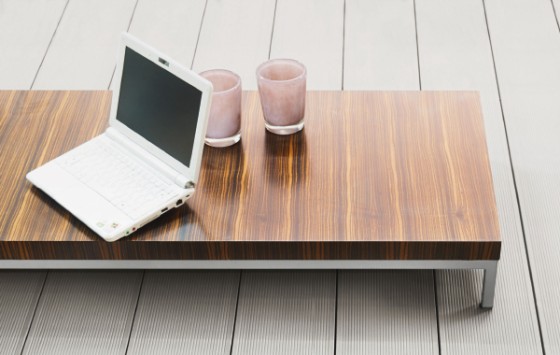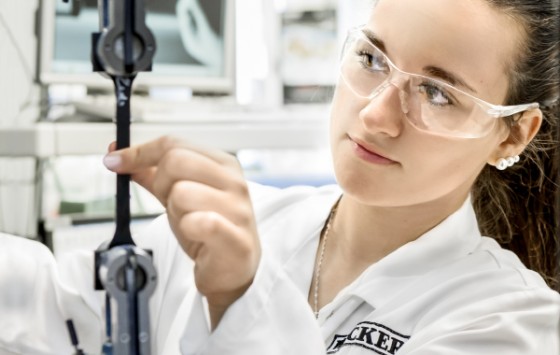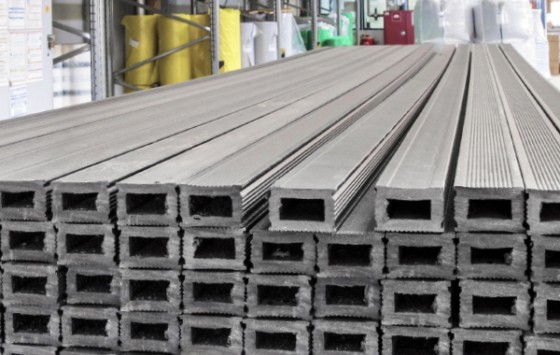The Best of Both Worlds
Compounds made of wood and plastic combine the positive properties of both materials. Pinuform uses these kinds of compounds to produce particularly durable decking boards. To enhance the workability of its mixtures, the company employs a new silicone-based production aid.


The MOCOPINUS group, based in Ulm (Germany), can boast generations of experience with wood – it originated from a timber business that was founded in 1865 to ship logs across the Danube river. With some 300 employees, MOCOPINUS now ranks among Germany’s leading industrial planing mills and produces profiled timber out of Nordic spruce for sidings, wall and ceiling coverings, and decking boards.
MOCOPINUS generates some 30,000 metric tons of wood shavings during production every year. Until the late 1990s – when the market for composite materials made of wood and plastic started to grow rapidly in the USA – the shavings were mainly sold on as bedding for animal housing. “Then we realized that wood shavings are a valuable raw material that’s too good to just spread under animal hooves,” says Diethard Cascorbi.
Wood plastic composites are weather-resistant, stable, versatile and easy-to-process materials that unite the positive properties of wood with the advantages of plastic
Martin Schmid, Director Business Team Plastics + Coatings EMEA & Global Marketing
Decking supplied by Pinuform, a subsidiary of the Ulm-based MOCOPINUS Group. Pinuform processes wood shavings into wood plastic composites.
A qualified plastics engineer, Cascorbi was hired by the wood specialists in Ulm to further develop the new business field of wood plastic composites (WPCs). These consist mainly of wood fibers, to which up to 35 percent of an organic plastic is added – in Europe, usually polyethylene or polypropylene – plus fillers and additives, which ensure that the wood fibers form an optimum bond with the polymer matrix. Manufacturers are interested in as high a wood content as possible, since the petroleum-based polyolefins are naturally considerably more expensive than wood fibers. The processor then molds the mixture into the required shape by extrusion.
The Pinuform subsidiary was founded for this new business field and, in 2005, brought its first decking boards made of wood-based composite onto the market. Since the business enjoyed a successful start, Pinuform set up further production lines in Naunhof near Leipzig in 2011.
Strong Market Growth
WPCs are suited to numerous applications – beside decking boards, possible products include sidings and fences, windows and doors, furniture, parts for vehicle interiors, and technical components. The market for these composite materials has been booming for several years and is growing at an annual rate of around 20 percent. In China, which is the world’s biggest WPC producer alongside the USA, it’s even 25 percent – the strongest growth market.
“Wood plastic composites are weather-resistant, stable, versatile and easy-to-process materials that unite the positive properties of wood with the advantages of plastic,” explains Martin Schmid, Director Business Team Plastics + Coatings EMEA & Global Marketing.

The Pinuform experts conducted their first trials of mixing and manufacturing this material in the early 2000s. By now, their expertise is considerable. First, the wood shavings are ground in a mill into wood flour with a diameter of at most 630 micrometers – Pinuform’s WPC granules contain up to 70-percent wood. Then, together with the plastic, additives and fillers, they are made into a homogeneous compound.
At this point, it would be possible to immediately process the still-hot compound further by extrusion molding to make the desired solid or hollow profiles. However, Pinuform uses a two-step process. The mixture is first granulated underwater. The reason for this is that Pinuform also sells granules on to other companies, including competitors. In Naunhof, some of the granules are then melted down again and processed further by extrusion to make the desired end product – decking boards in this case.
Minimizing Friction Losses

“One of the main challenges encountered in the production process is ensuring that all components mix well with each other and that there is as little resistance as possible during the molding process,” reports Dr. Peter Randel, who deals with new business fields at WACKER’s Corporate R&D. Generally, 2% to 6% of a lubricant – usually stearates or PE waxes – is added to minimize friction losses. With GENIOPLAST® additives based on a silicone elastomer, WACKER has now developed a new production aid that allows WPC processors to use it in significantly lower amounts. With this silicone copolymer, manufacturers need to use only a small amount of the pure component.
The reason for this is that the WACKER silicone, which was developed jointly with the Wood Competence Center in Linz (Austria), is ten times more active than standard lubricants. For this reason, WACKER offers WPC processors a masterbatch, where the active-ingredient component has already been mixed with the respective plastic (formulations containing polypropylene and polyethylene are currently available) and are sold commercially as GENIOPLAST® brand granules. The masterbatch consists of one-fifth WACKER copolymer and four-fifths plastic.
WPC manufacturers only need to add 1% of the masterbatch to achieve the desired effect. Thanks to this preformulated ready-to-use mixture, the production aid can be ideally integrated into WPC processing and mixed in easily. “During the extrusion step, GENIOPLAST® additives ensure smooth movement of the WPC material in the extruder, reducing friction against the exterior wall,” explains Randel, who developed the application of these silicone additives at WACKER’s Corporate R&D.
Faster Extrusion

Deniz-Neslihan Kacar from WACKER’s silicone copolymers research unit determines the tensile strength of a WPC test piece in the lab.
At the same time, the wood particles also slide past each other more readily, because WACKER’s copolymers consist of a polar urea unit that attaches to the wood particles via hydrogen bonds. The non-polar silicone chain projects outwards and the thus functionalized wood particles slide past each other better. This lowers the coefficient of friction, which, in turn, reduces the amount of energy required for the entire process. On top of that, “the extrusion speed increases – as does the throughput – even if we naturally cannot quantify this exactly,” explains Pinuform’s divisional manager Diethard Cascorbi.
In addition, GENIOPLAST® optimizes the dispersion properties of wood and other natural fibers in the respective polymers. The compatibility of the polar natural-fiber surfaces in a non-polar polymer matrix is also enhanced. “The material becomes more homogeneous, it mixes better,” confirms Cascorbi, a plastics engineer by training.

GENIOPLAST® additives do not adversely affect the WPC material’s positive properties – unlike conventional lubricants, which often have an unfavorable effect on technical characteristics such as the modulus of elasticity, flexural strength, impact strength and water absorption. “With its new masterbatch based on thermoplastic silicone elastomers, WACKER has developed an innovative process aid with which the production of wood plastic composites can be made more cost-effective overall,” emphasizes Randel.
Low Water Absorption

A look inside Pinuform’s production facilities: wood plastic composites can also be used to make hollow profiles.
WPC products processed with the WACKER copolymer also display lower water absorption, so that the material expands and distorts less in the presence of moisture. Cascorbi regularly tests out the WPC profiles made in Naunhof by storing them in saucepans – after five hours in boiling water, the weight gain is less than 2%.
Their low water absorption helps make WPC decking boards considerably more durable than those made of Douglas fir or larch. Pinuform’s wood-plastic boards come with a ten-year warranty, for example – this only excludes color fastness, as the lignin in the wood degrades when exposed to UV light. This effect – fading under sunlight – may even be desirable, because it makes WPCs look more similar to solid wood.
“WPCs allow the woodworking industry to open up another line of business and thus extend its supply chain,” explains Cascorbi. Due to their considerable weathering resistance, easy pigmentability and design flexibility, the materials offer an attractive alternative to pure plastics, especially for the furniture, construction and automotive industries – WPC elements are more rigid and have a greater tensile strength. What’s more, they boast low thermal expansion, good damping properties and little shrinkage.
Hollow Profiles Also Possible
GENIOPLAST®
This is WACKER’s trademark for silicone-based additives that are used in the plastics industry for the compounding of thermoplastics. These additives come in the convenient form of pellets, which enables them to be used very easily in all conventional production processes. As processing aids, they prevent die drool on the extruder, as well as making it possible to reduce die pressure and torque, and improving melt flow. As additives, they increase scrub resistance, decrease friction coefficient and enhance how the compound feels. Based on GENIOPLAST®, WACKER has developed its own production aid for wood plastic composites.
Apart from extrusion molding, wood plastic composites can also be processed by injection molding or other molding techniques. When visiting customers, Cascorbi always brings along a suitcase full of WPC molded parts, which range from planting boxes to battery housings and WPC sheets and panels. The option of producing hollow as well as solid profiles offers attractive alternatives for lightweight-construction applications.
Another advantage is that the wood content in wood plastic composites can be tailored to suit regional conditions and material property requirements. While WPC production in Europe and the US relies mainly on softwood, hardwood is preferred in Asia – alongside other biobased fillers such as rice husks. “This makes the material a more sustainable product with which industrial customers will be able to improve their carbon footprint in the future,” emphasizes WACKER’s Martin Schmid.
As it grows, wood – unlike other construction materials such as concrete – binds carbon dioxide instead of emitting it during manufacture.

